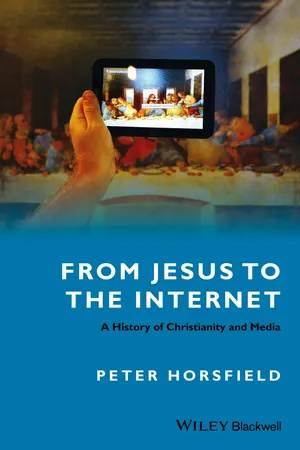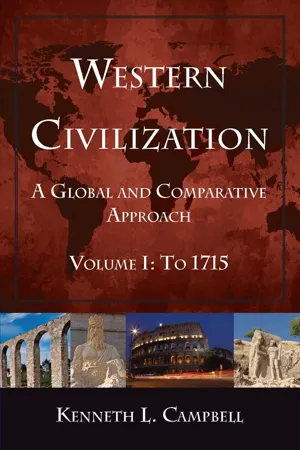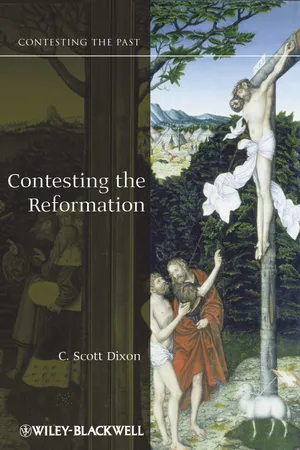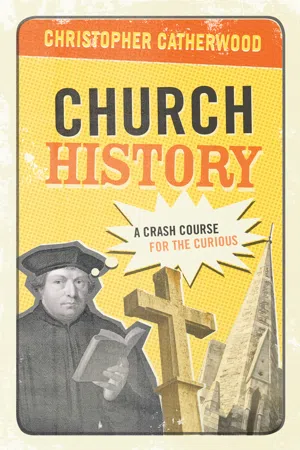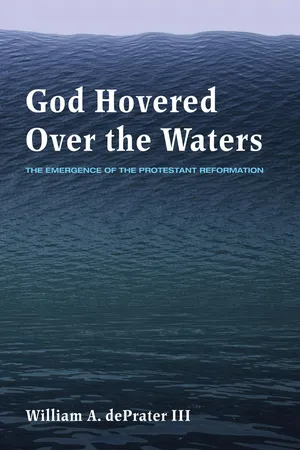History
German Reformation
The German Reformation was a religious and political movement in the 16th century led by Martin Luther, which aimed to reform the Roman Catholic Church. Luther's Ninety-Five Theses, published in 1517, challenged the church's practices and led to the establishment of Protestantism. The movement had a profound impact on German society, politics, and religious life.
Written by Perlego with AI-assistance
Related key terms
5 Key excerpts on "German Reformation"
- eBook - ePub
From Jesus to the Internet
A History of Christianity and Media
- Peter Horsfield(Author)
- 2015(Publication Date)
- Wiley-Blackwell(Publisher)
10 ReformationThe Reformation is the term now given to the complex of religious and political changes that occurred in Western Christendom during the sixteenth and seventeenth centuries. It was marked particularly by the fracturing of the singular Holy Roman Empire into a continuing European-wide Roman Catholic Church and a diversity of “Protestant” forms of Christian expression and organization. It is commonly seen as being initiated in 1517 by the nailing on the door of Wittenberg cathedral ninety-five theses of protest (in Latin) by Martin Luther. It is also seen as a major event of media significance within Christianity because of its connection with the expanding uses of printing. The nature and consequences of that connection are explored in this chapter.Printing and its precursors
Printing emerged in the West in the fifteenth century as part of a wider convergence of cultural changes. The Scholastic movement had instigated a mechanism for rethinking the previously unquestioned assumptions of dogma. Developments in agriculture had facilitated new commerce and trade, the rise of a merchant class, the growth of cities and urban populations where new economic principles guided social relationships, and changing structures of authority. During the fourteenth and fifteenth centuries, new universities were established in major centers of Europe that expressed and fed the rise of Renaissance Humanism, a cultural movement of thought, technological change, and artistic expression that was generating a new sense of human individualism and scope to develop. New technologies such as the compass, lensmaking, and the telescope were changing people’s perspectives on the universe and their place within it.Within this ferment, the Holy Roman Church across Europe was rent by unrest. Political collusion and papal tolerance of corruption were creating problems of morale, trust, and integrity, reflected in a steady stream of individual reformers and reform movements as noted in chapter 9. Monarchs were becoming more efficient in the business of governing and asserting themselves against the dominance of the Roman imperial church. The three most powerful western monarchies emerged in this period: England in 1485, France in 1491, and Spain in 1492. - eBook - ePub
Western Civilization: A Global and Comparative Approach
Volume I: To 1715
- Kenneth L. Campbell(Author)
- 2014(Publication Date)
- Routledge(Publisher)
Chapter 4 in Volume II). Both Catholics and Protestants relied heavily on logic and rational argument to defend their positions, regarding God as a being whose existence could be proved and demonstrated. Many Catholics and Protestants believed that two religions could not coexist within the same state, although in practice Catholics and Protestants in a number of local communities across Europe found a way to do just that. Both Catholic and Protestant rulers regarded religious uniformity as a prerequisite for political loyalty. Both persecuted religious minorities and feared countries with a different religion as real or potential enemies. Thus religion came to shape much of the political discourse that followed the Reformation.The Reformation had a number of social consequences, although these have been widely debated among historians. The Reformation was in some ways related to the development of a more individualistic society, though which was the cause and which the effect is a complicated matter. The Reformation offered alternative views on marriage, sexuality, education, the role of women in society, and poor relief. If the period did not fundamentally alter the patriarchal and hierarchical nature of European society, it both reflected and contributed to social changes that did affect the lives of individual men and women, especially in those lands most affected by the Reformation. Finally, because the Reformation movement coincided with a period of European exploration and overseas travel, the religious controversies of Europe were transported to the far corners of the globe within a relatively short period of time.1. What were the decisive factors and events leading to Martin Luther’s break with the Roman church?2. Discuss the social consequences of the Reformation. In particular, what impact did the Reformation have on women? Would attitudes have changed in this period independent of the religious changes that were occurring?3. - eBook - ePub
- C. Scott Dixon(Author)
- 2012(Publication Date)
- Wiley-Blackwell(Publisher)
In modern studies, however, there has been a shift away from a focus on Luther to broader questions of context, the result being that more recent historiography tends to analyze how the Reformation sat in relation to the cultural and material conditions of the time. The grand narratives of Ranke and the explanatory theories of Weber and Troeltsch have largely been abandoned, or at least critically intermitted, and replaced by a more source-based, contextualized study of the movement that pays attention to the unique social, political, and cultural aspects of the German lands. 58 With reference to origins, for instance, greater stress is now placed upon the cultural preconditions that facilitated the rise of the movement, including the importance of print culture, the anticlericalism of the medieval age, the growing sense of national identity, and the intellectual climate on the eve of reform. In a similar manner, the debates relating to the great variety of political settings of the rise of the Reformation – the tripartite division of commune, city, and territory – have revealed the complexity of the social and political environments and the consequent need to examine the dynamics at the local levels in order to understand impact. Overarching theories still exist, of course, perhaps the best example in recent years being the paradigm of confessionalization, but scholarship in general has become more specialized and inclined to situate the problematic in specific contexts. 59 But the essential framework for understanding the Reformation remains the German lands. As Moeller himself has suggested, in its essentials the Reformation was a German event before it became a European phenomenon. 60 Scholarship in the Netherlands approaches the Reformation differently, due primarily to the nature of the history it relates - eBook - ePub
Church History
A Crash Course for the Curious
- Christopher Catherwood(Author)
- 2007(Publication Date)
- Crossway(Publisher)
It was similar, albeit on a smaller scale, in other parts of Europe as well. Kings and princes discovered that they could exercise political control over their local clergy, who could not, in a Protestant state, appeal to Rome for help. No longer could some proud king such as Henry VIII be denied his wishes by a Pope hundreds of miles away and outside of his control.Luther, we must remember, did not set out to create a new form of Christian church—it was imposed upon him by outside events. This is important—we cannot accuse Luther, as Catholics have done, of splitting Christianity since it was papal reaction, and that of Catholic princes in Germany, especially the Emperor Charles V, that actually did the splitting by the way in which they treated Luther. Having said that, a split would inevitably have come sooner or later since it was obvious to increasing numbers of godly people that what was wrong with the Catholic Church was more than cosmetic, but actually something doctrinally and fundamentally wrong.Without the thought processes through which Luther traveled, the Reformation would not have been possible. For while Erasmus and similar folk knew what had gone wrong with the Roman Catholic Church, they had stayed within it. Through understanding what the Bible itself actually taught, Luther realized that cosmetic changes to the Catholic Church would not be enough—what was required was something infinitely more drastic and fundamental.The Catholic ReactionEventually the Catholic hierarchy and princely supporters realized that Protestantism was there to stay and could not be crushed, militarily or otherwise.Historically this has been known as the Counter-Reformation. Historians now like to see the whole process as one of continual change and use the word Reformation - eBook - ePub
God Hovered Over the Waters
The Emergence of the Protestant Reformation
- dePrater(Author)
- 2015(Publication Date)
- Wipf and Stock(Publisher)
3 The Reformation in Germany Martin Luther P eter Marshall describes it this way: It starts in a thunderstorm in the summer of 1505. On the road near Erfurt, in the Germany principality of Saxony, a young law student is caught in a downpour, and fears for his life amidst ferocious strikes of lightning. He prays to St. Anne, the mother of the Virgin Mary, offering a bargain: if she will spare his life, he will become a monk. A fortnight later, he bangs on the door of the Erfurt house of the reformed Augustinian friars, one of the strictest of all the religious orders. 15 Martin Luther told this story about himself many decades later. It was his attempt to explain the unexplainable—how he had experienced the Holy Other in the midst of a thunderstorm, and how that experience had shaped his life. Apostle Paul met the risen Christ on the Road to Damascus. Young Moses realized that he was standing in God’s presence before the burning bush. Prophet Isaiah experienced God’s presence in the smoke-filled temple. Likewise, on the road from Mansfield to Erfurt, the twenty-one-year-old Martin Luther realized the presence of God amidst the terrible thunder, blinding lightening, and drenching downpour. God later would use Luther as tinder in order to set the world aflame with the spirit of spiritual reformation. The Early Years Luther was born in Eisleben, Germany, in 1483, the year prior to the birth of another reformer, Huldrych Zwingli. As he was born on the feast of St. Martin of Tours, his parents named him Martin. He would be the eldest of seven children, with only one brother (Jacob or James) and three sisters surviving to adulthood. His other two brothers died in the 1505 plague. Luther’s birth likewise occurred only a year after the printing of Ptolemy’s second-century maps, which reshaped people’s understanding of the world. Luther’s father, Hans Luther, was of peasant origin, and never learned to read
Learn about this page
Index pages curate the most relevant extracts from our library of academic textbooks. They’ve been created using an in-house natural language model (NLM), each adding context and meaning to key research topics.
